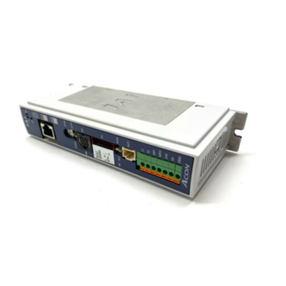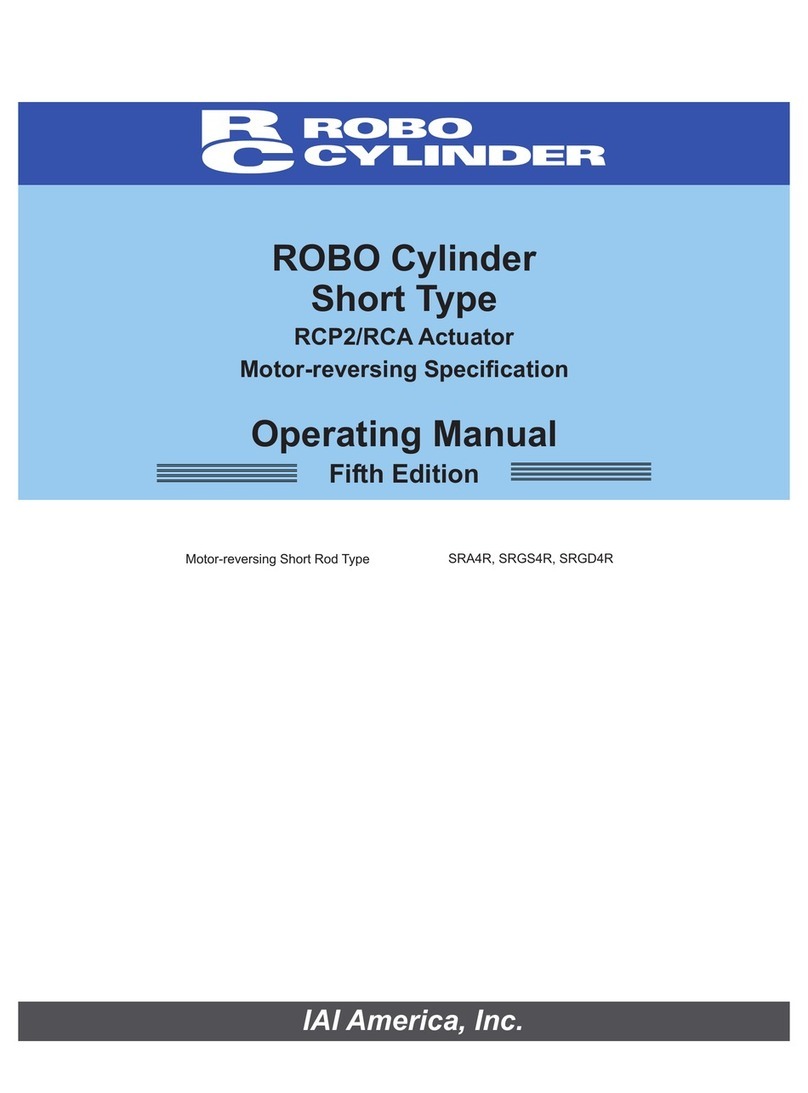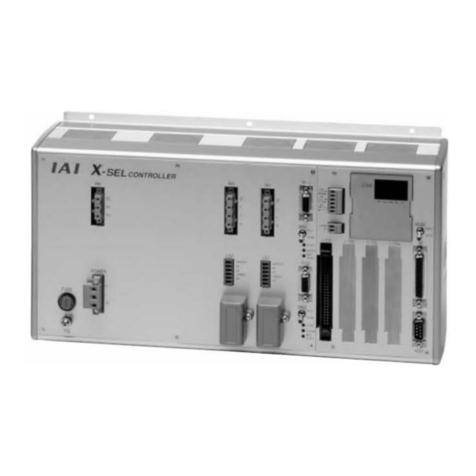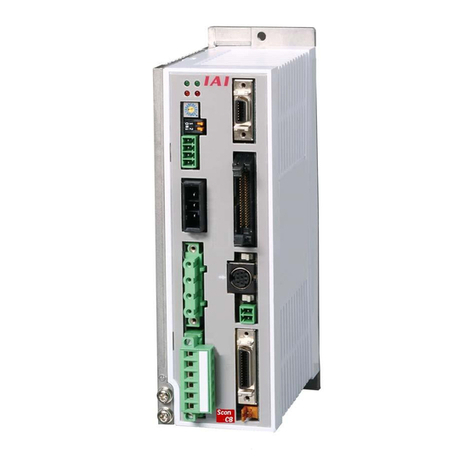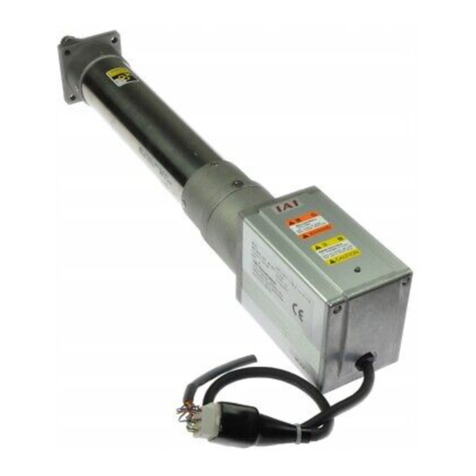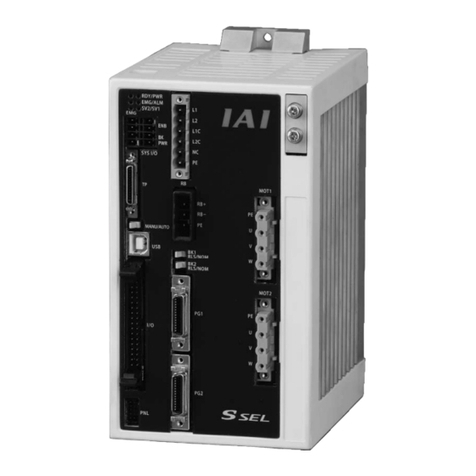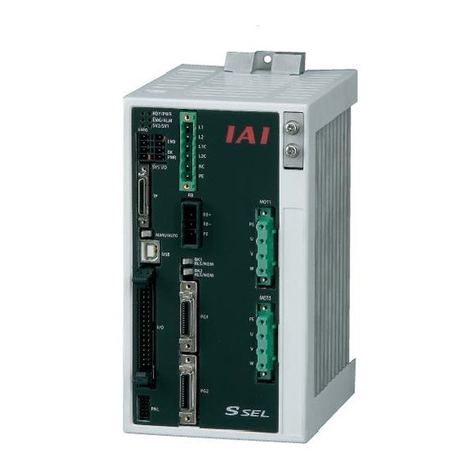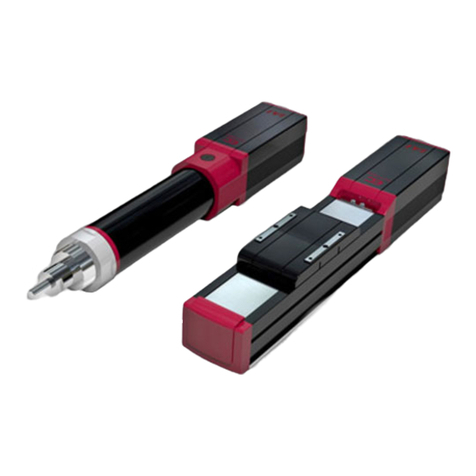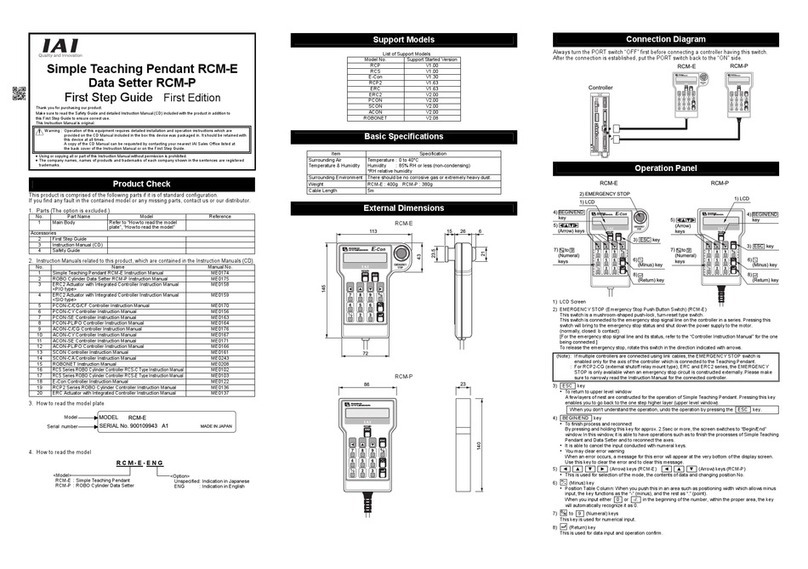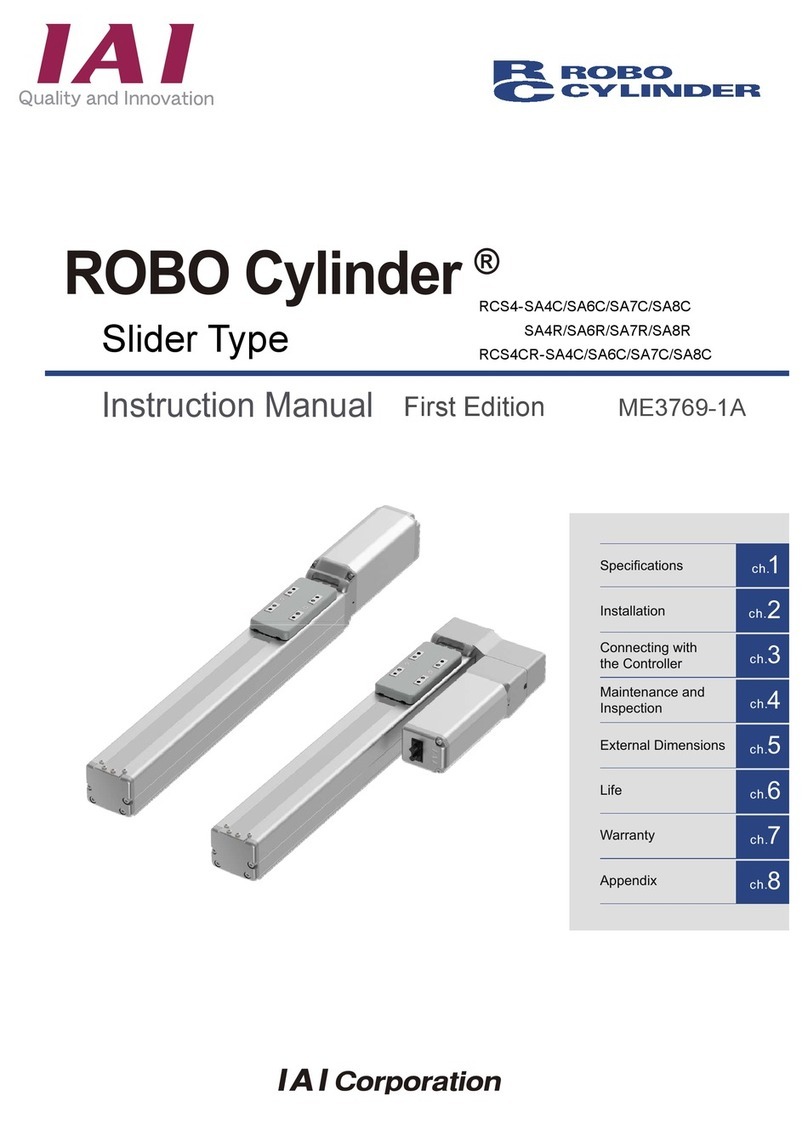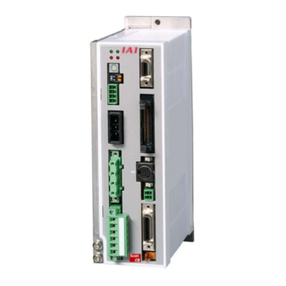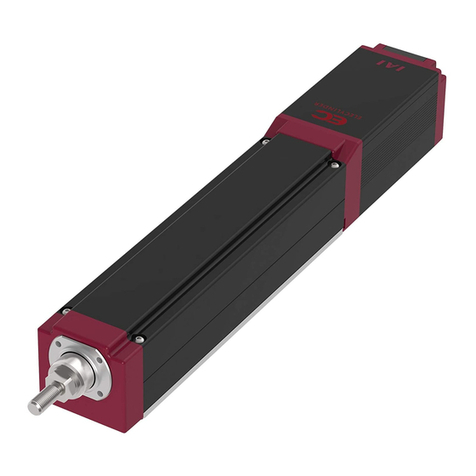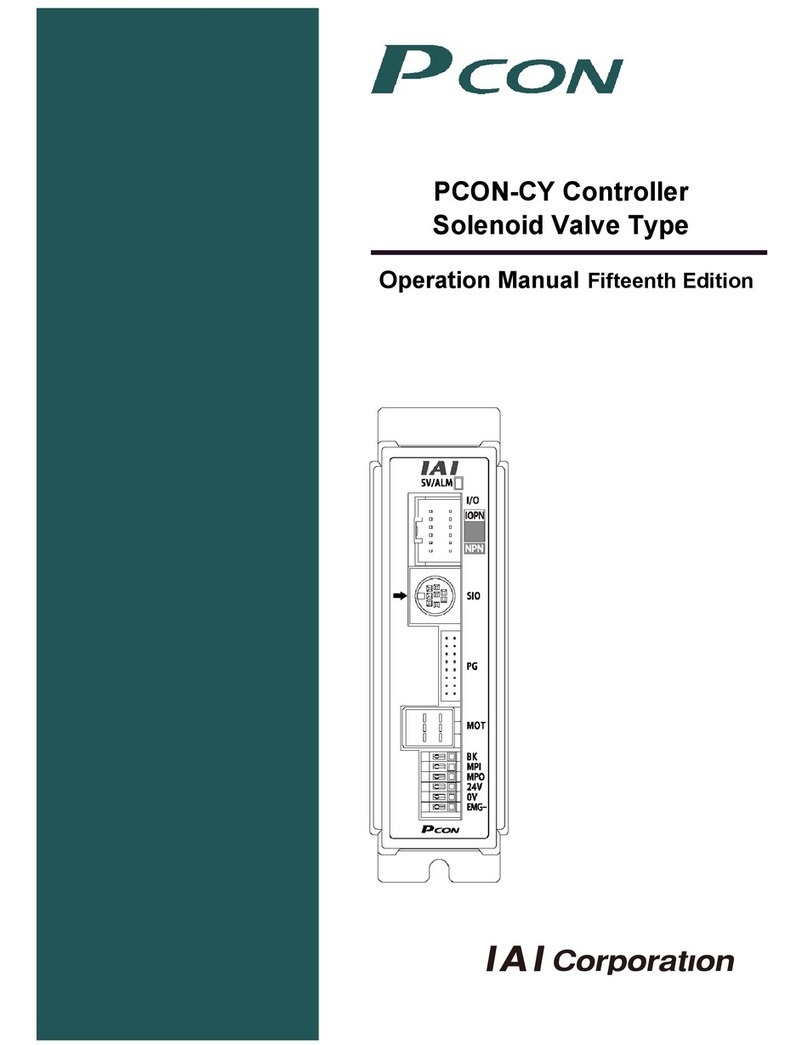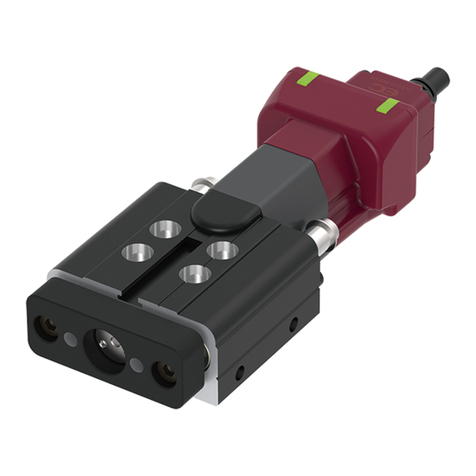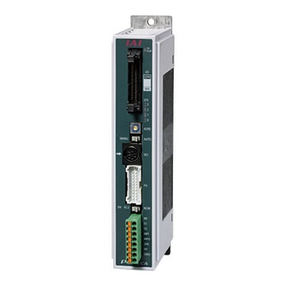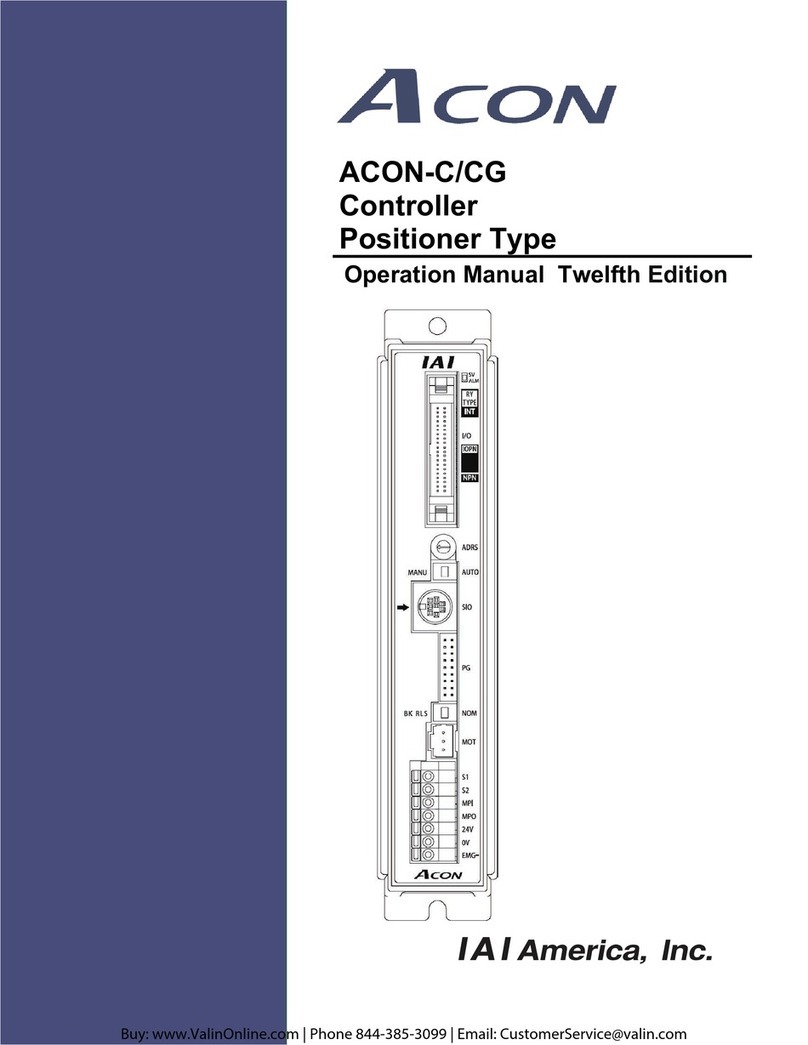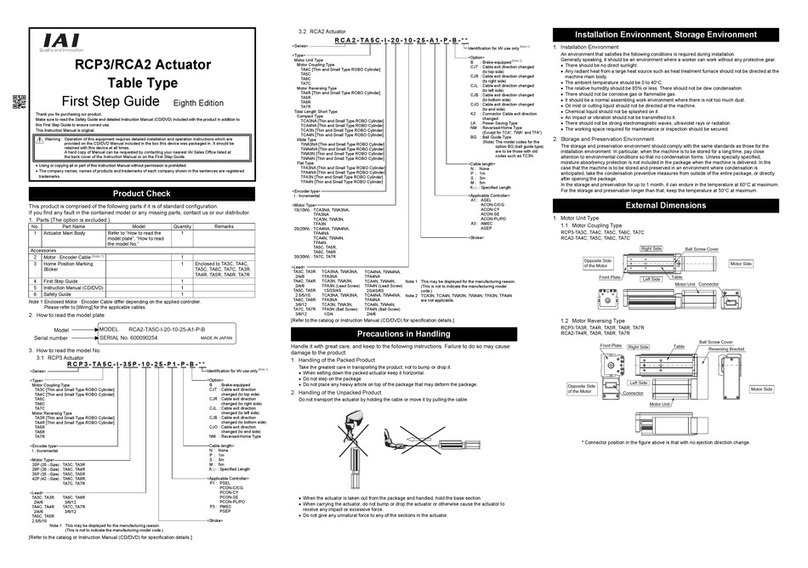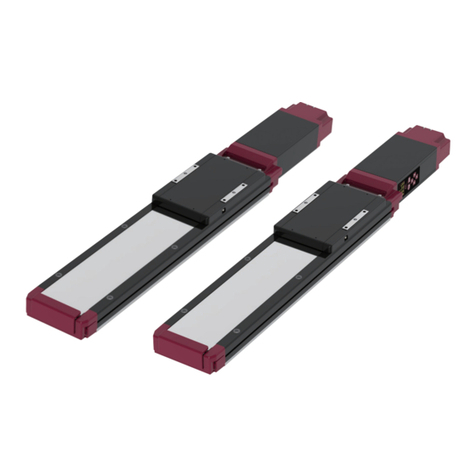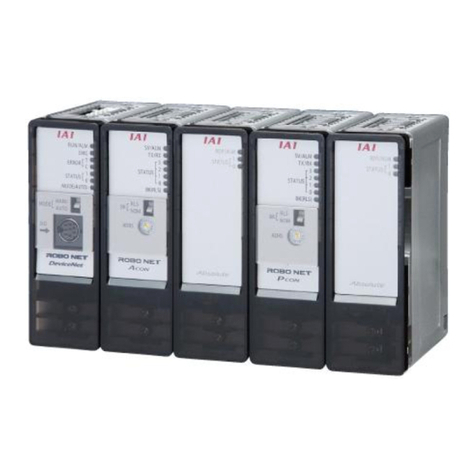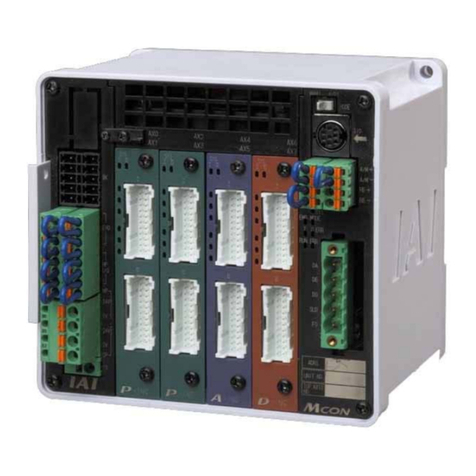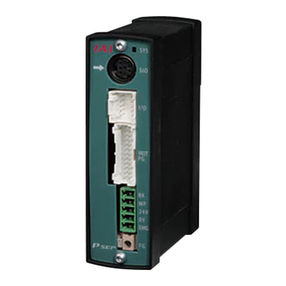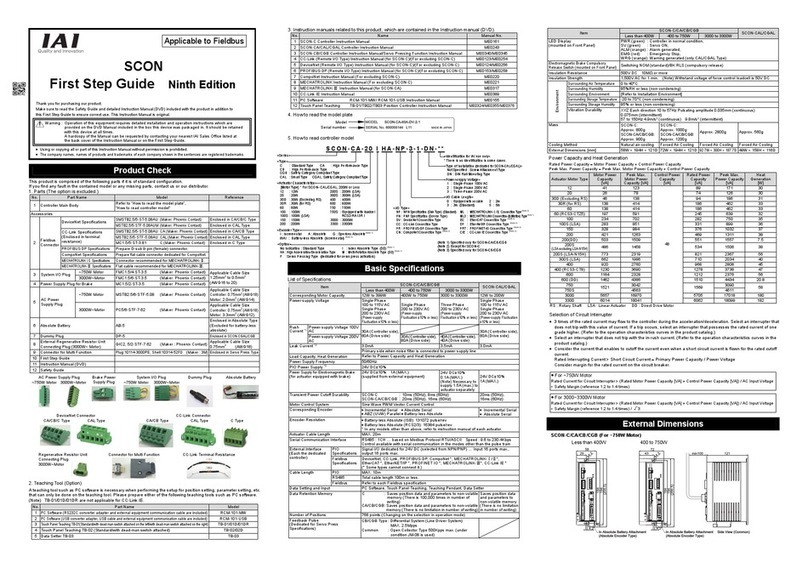SCON
First Step Guide Seventh Edition
Thank you for purchasing our product.
Make sure to read the Safety Guide and detailed Instruction Manual (DVD) included with the product in addition to
this First Step Guide to ensure correct use.
This Instruction Manual is original.
•Using or copying all or part of this Instruction Manual without permission is prohibited.
•The company names, names of products and trademarks of each company shown in the sentences are registered
trademarks.
Product Check
This product is comprised of the following parts if it is of standard configuration.
If you find any fault in the contained model or any missing parts, contact us or our distributor.
1. Parts
No. Part Name Model Reference
1 Controller Main Body
Refer to “How to read the model plate”, “How to read the model”
Accessories
2 I/O Flat Cable CB-PAC-PIO*** *** shows the cable
length
3 Service Connector for Pulse
Train Control Plug : 10114-3000PE, Shell : 10314-52F0 (Supplier : 3M) Enclosed in SCON-C/CA
4 System I/O Plug FMC1.5/4-ST-3.5 (Supplier : Phoenix Contact)
5 Power Supply Plug for Brake MC1.5/2-ST-3.5 (Supplier : Phoenix Contact)
Applicable Cable Size
0.5mm2(AWG20)
6 AC Power Supply plug MSTB2.5/6-STF-5.08 (Supplier : Phoenix Contact) Applicable Cable Size
2.0mm2(AWG14)
7 Absolute Battery AB-5 Enclosed in Absolute Type
8 Dummy plug DP-5 Enclosed in SCON-CGAL
9 First Step Guide
10 Instruction Manual (DVD)
11 Safety Guide
2. Teaching Tool (to be purchased separately)
A teaching tool such as PC software is necessary when performing the setup for position setting, parameter
setting, etc. that can only be done on the teaching tool.
Please prepare either of the following teaching tools such as PC software.
No. Part Name Model
1 PC Software
(RCS232C converter adapter and external equipment communication cable are included) RCM-101-MW
2 PC Software
(USB converter adapter, USB cable and external equipment communication cable are included)
RCM-101-USB
3 Touch Panel Teaching CON-PTA CON-PTA
4 Touch Panel Teaching CON-PDA (Dead-man switch is included) CON-PDA
5 Touch Panel Teaching CON-PGAS (Dead-man switch and TP adapter are included) CON-PGAS
6 Touch Panel Teaching TB-01 TB-01
7 Touch Panel Teaching TB-01 (with dead-man switch attached on the left) TB-01D
8 Touch Panel Teaching TB-01 (with dead-man switch attached on the right) TB-01DR
3. Instruction manuals related to this product, which are contained in the Instruction manual (DVD).
No. Name Manual No.
1 SCON Controller Instruction Manual ME0161
2 SCON-CA/CAL/CGAL Controller Instruction Manual ME0243
3 PC Software RCM-101-MW/ RCM-101-USB Instruction Manual ME0155
4 Touch Panel Teaching CON-PTA/PDA/PGAS Instruction Manual ME0295
5 Touch Panel Teaching TB-01 Position Controller Instruction Manual ME0324
4. How to read the model plate
5. How to read controller model
Basic Specifications
List of Specifications
SCON-C/CA
Item
Less than 400W 400W or more
SCON-CAL/CGAL
Corresponding Motor Capacity 12W to 399W 400W to 750W 12W to 200W
Power-supply Voltage
Single-Phase 100 to 115V AC
(Power fluctuation within
±
10%)
Single-Phase 200 to 230V AC
(Power fluctuation within
±
10%)
Single-Phase 200 to 230V AC
(Power fluctuation within
±
10%)
Single-Phase 100 to 115V AC
(Power fluctuation within
±
10%)
Single-Phase 200 to 230V AC
(Power fluctuation within
±
10%)
Power-supply Voltage 100V AC
Rush
Current*1
Power-supply Voltage 200V AC
20A (Controller side), 70A
(Drive side) 20A (Controller side),
80A (Drive side)
30A (Controller side),
80A (Drive side)
Load Capacity Refer to Power Capacity and Heat Generation
Leak Current*2 3.0mA Primary side when noise filter is connected to power supply line
Heat Generation Refer to Power Capacity and Heat Generation
Power Supply Frequency 50/60Hz
PIO Power Supply*3 24V DC±10%
Power Supply for Electromagnetic Brake
(for actuator equipped with brake)
24V DC±10% 1A (MAX.)
(supplied from external equipment)
SCON-C : 10ms (50Hz), 8ms (60Hz)Transient Power Cutoff Durability
SCON-CA : 20ms (50Hz), 16ms (60Hz)
20ms (50Hz), 16ms (60Hz)
Motor Control System Sine Wave PWM Vector Current Control
Corresponding Encoder Incremental Serial Encoder, Absolute Serial Encoder,
ABZ (UVW) Parallel Encoder
Incremental Serial Encoder,
Absolute Serial Encoder,
Actuator Cable Length MAX. 20m
Serial Communication Interface RS485 : 1CH … based on Modbus Protocol RTU/ASCII
Speed : 9.6 to 230.4Kbps
Control available with serial communication in the modes other than the pulse train
PIO
Specifications
Signal I/O dedicated for 24V DC (selected from NPN/PNP) … Input 16 ports max.,
output 16 ports max.
External Interface
(Each dedicated
controller) Fieldbus
Specification
DeviceNet/CC-Link/PROFIBUS/CompoNet*/MECHATR
OLINK*/EtherCAT*/EtherNET/IP*/PROFINET IO*
(*Specified only for SCON-CA)
DeviceNet/CC-Link/PROFIB
US/CompoNet/MECHATRO
LINK/EtherCAT/EtherNET/I
P/PROFINET IO
PIO MAX. 10m
RS485 Total cable length 100m or less.
Cable Length
Fieldbus Refer to each Fieldbus specification
Data Setting and Input PC Software, Touch Panel Teaching, Teaching Pendant
SCON-C : Saves position data and parameters to
non-volatile memory
(Limitation in number of writing 100,000 times)
Data Retention Memory
SCON-CA : Saves position data and parameters to
non-volatile memory
(There is no limitation in number of writing)
Saves position data and
parameters to non-volatile
memory
(There is no limitation in
number of writing)
Operation Mode Positioner Mode/Pulse Train Control Mode
(selected by Pulse Train Mode Changeover Switch on
Front Panel)
Positioner Mode
Number of Positions in Positioner
Mode
Standard 64 points, maximum 512 points (PIO Type), 768 points (only for SCON-CA Fieldbus Type)
(Note) Number of positions differs depending on the selection in PIO pattern and fieldbus operation mode.
SCON-C : Differential System (Line Driver System) :
MAX. 500Kpps
SCON-CA : Differential System (Line Driver System) :
MAX. 2.5Mpps
Input Pulse Frequency
Common to C/CA
: Open Collector Type :
200Kpps max. (under condition AK-04 is used)
Pulse Train
Control
Mode
(Dedicated
for PIO
Specifications)
Command Pulse
Multiplying Factor
(Electrical Gear : A/B)
1/50 < A/B <50/1
Setting Range of A and B (set to parameter) : 1 to 4096
SCON-C :
Differential System (Line Driver
System
):
MAX. 500Kpps (Linear output available up to
109Kpps)
SCON-
CA
:
Differential System (Line Driver System):
MAX. 2.5Mpps
Feedback Pulse
(Dedicated for PIO Specifications)
Common to C/CA
:
Open
Collector Type
:
MAX. 500Kpps (under condition JM-08 is used)
LED Display
(mounted on Front Panel)
PWR (green) : Controller in normal condition,
SV (green) : Servo on,
ALM (orange) : Alarm generated,
EMG (red) : Emergency Stop
PWR (green) : Controller in
normal condition / SV
(green) : Servo on / ALM
(orange) : Alarm generated /
EMG (red) : Emergency
Stop / WRG (orange) :
Warning generated
Electromagnetic Brake Compulsory Release
Switch (mounted on Front Panel)
Switching NOM (standard)/BK RLS (compulsory release)
Insulation Resistance 500V DC 10MΩor more
Insulation Strength 1,500V AC for 1 min. (Note) Withstand voltage of force control loadcell is 50V DC
Surrounding air temperature
0 to 40°C
Surrounding humidity
85%RH or less (non-condensing)
Surrounding environment
[Refer to Installation Environment]
Surrounding storage temperature
-20 to 70°C (non-condensing)
Surrounding storage humidity
85% or less (non-condensing)
Environment
Vibration Durability
XYZ Each direction 10 to 57Hz Pulsating amplitude 0.035mm (continuous) 0.075mm (intermittent)
57 to 150Hz 4.9m/s
2
(continuous) 9.8m/s
2
(intermittent)
Protection Class IP20 or equivalent
Weight SCON-C : Approx. 800g
SCON-CA : Approx. 900g
SCON-C : Approx. 1100g
SCON-CA : Approx. 1200g
Approx. 560g
Cooling Method Natural air-cooling Forced Air Cooling Forced Air Cooling
External Dimensions 58W ×194H ×121D [mm] 72W ×194H ×121D [mm] 49W ×158H ×116D [mm]
*1 In-rush current will flow for approximately 20msec after the power is turned on (at 40°C).
Note that the value of in-rush current differs depending on the impedance of the power supply line.
*2
Leak current varies depending on the capacity of connected motor, cable length and the surrounding environment. Measure the
leak current at the point where a ground fault circuit interrupter is to be installed when leakage protection is conducted.
A ground fault circuit interrupter needs to be selected carefully considering the purposes of prevention of fire and
protection of human.
Use the harmonic type (for inverter) for the ground fault circuit interrupter.
*3 It is not necessary to supply power to PIO when operating with using ROBONET, Gateway Unit or SIO Converter
without using PIO. In this case, set the parameter No. 74 (PIO Power Supply Monitor) to “1” (Invalid). It will generate
the error code No. 0CF (I/O 24V Power Supply Error) if the setting is not done.
Power Capacity and Heat Generation
Rated Power Capacity =Motor Power Capacity +Control Power Capacity
Peek Max. Power Capacity =Peek Max. Motor Power Capacity +Control Power Capacity
Actuator Motor Type
Motor Power
Capacity
[VA]
Peek Max. Motor
Power Capacity
[VA]
Control Power
Capacity
[VA]
Rated Power
Capacity
[VA]
Peek Max. Power
Capacity [VA]
Heat Generation
[W]
12 41 123 89 171 30
30D (Excluding RS) 46 138 94 186 31
30R (for RS) 138 414 186 462 33
60 138 414 186 462 33
60 (RCS3-CTZ5) 197 591 245 639 32
100 234 702 282 750 35
100S (LSA) 283 851 331 899 36
150 328 984 376 1032 37
200 421 1263 469 1311 38
200S
(LSA excluding LS A-N15H)
486 1458 534 1506 38
200S (LSA-N15H) 773 2319 821 2367 56
300S (LSA) 662 1986 710 2034 40
400 920 2760 968 2808 45
400 (RCS3-CT8) 1230 3690 1278 3738 47
600 1164 2328 1212 2376 56
750 3042 3090
750S 1521 4563
48
1569 4611 58
RS : Rotary Shaft LSA : Linear Actuator
Selection of Circuit Interrupter
• 3 times of the rated current flows to the controller during the acceleration/deceleration. Select an interrupter that does not trip
with this value of current. If a trip occurs, select an interrupter that possesses the rated current of one grade higher. (Refer to
the operation characteristics curves in the product catalog.)
• Select an interrupter that does not trip with the in-rush current. (Refer to the operation characteristics curves in the product
catalog.)
• Consider the current that enables to cutoff the current even when a short circuit current is flown for the rated cutoff current.
Rated Interrupting Current >Short Circuit Current =Primary Power Capacity / Power Voltage
Consider margin for the rated current on the circuit breaker.
Rated Current for Circuit Interrupter >(Rated Motor Power Capacity [VA] +Control Power Capacity [VA]) /
AC Input Voltage ×Safety Margin (reference 1.2 to 1.4 times)
External Dimensions
SCON-C/CA
Less than 400W 400W or more
SCON-CAL/CGAL
DIN Rail
(8.5)
35.4 (Width of 35mm DIN Rail )
* There is no DIN rail part on the type with screw attachment. For DIN Rail
Mounting Type
82.5 from DIN rail center
130.7
116
4
49
158
(17)
For Screw-fixed Type
(6)
4.5
φ4.5
22.5
(6)
146.5
Serial numbe
